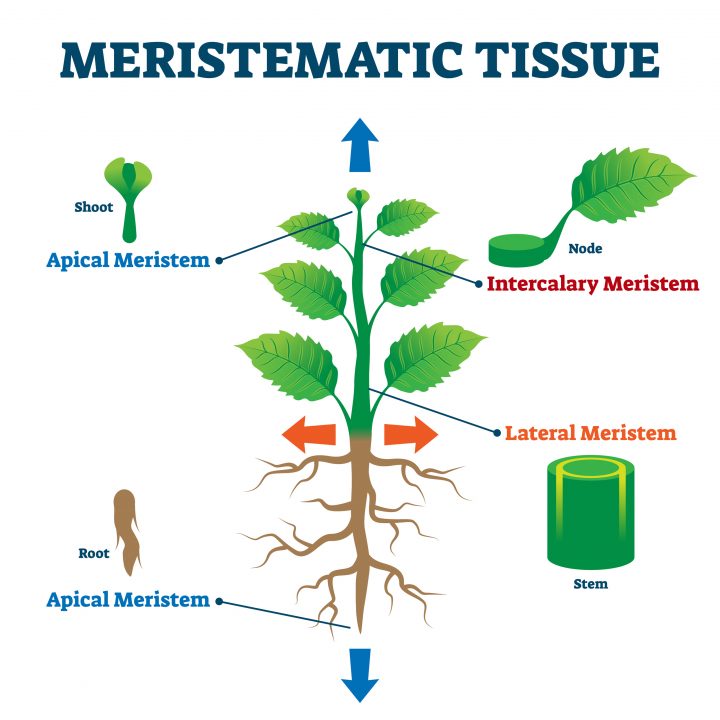
Representative picture of meristem culture and plantlet establishment
3.3 Meristem culture in vitro. Meristem culture in vitro is used for the elimination of viruses and related pathogens from a large number of vegetatively propagated plants and it is the main method used in plant virus elimination programs. The shoot apical meristem is comprised of the leaf primordia, which turn into leaves, and the apical dome.
Meristem Culture Definition, Procedure, Benefits, and Applications
Shoot Tip or Meristem Culture and Plant Breeding: In many plant breeding experiments, the hybrid plants produce abortive seeds or nonviable seeds. As a result, it makes a barrier to crossibility in plants where non-viable seeds are unable to develop into mature hybrid plants. Shoot tip or meristem from such hybrid plant can be cultured to.

Meristem tissue culture Lab Associates Lab Associates
Meristems. Meristems are regions of unspecialised cells in plants that are capable of cell division. Meristems make unspecialised cells that have the potential to become any type of specialised.

Meristem and Shoot Tip Culture Plant Cell Technology Your partner
The history of meristem culture essentially began with the first successful culture of meristem tips of Nasturtium (Tropaeolium majus) and formation of rooted plants (Ball, 1946). Since then meristem tip culture has attracted much attention from plant pathologists for its potential in production of virus-free plants.

Different stages of meristem culture in Abelmoschus esculentus. A
The meristem responds differently for the different age of the plants, plants genotypes, culture media, and plant growth hormones and their combinations (Alam et al., 2010).Meristem culture is the most important plant tissue culture technique; in addition to plant virus elimination, meristem is also used for mass propagation, germplasm storage, and genetic transformations.

Meristem culture
Shoot meristems, whether apical or axillary, are small domes (50-150 µ m in diameter) consisting of groups of a few actively dividing cells protected by developing leaves. The main physiological functions of meristems are the synthesis of protoplasm and the production of new cells. The biology and developmental morphology of the shoot apical.

Meristem Tissue Culture Laboratory. Stock Image Image of immature
At least plants derived by meristem culture methods show a much lower percentage of somaclonal variation, compared to those derived from callus cultures (see Sects. 13.1 and 13.6.3). However, attempts of molecular characterization of the genome of plants derived by meristem cultures are rare. The uppermost shoot tip without conductive elements.

Meristem tissue culture. stock photo. Image of botany 78991896
Among the prevalent tissue culture techniques of agricultural and horticultural promise, meristem and shoot tip culture has been exploited at a much wider scale primarily due to its application in diverse areas such as rapid clonal multiplication of vegetatively propagated crop plants, virus elimination and germplasm preservation of both vegetatively and seed propagated crops (Kartha, 1981.

Explant selection and callus induction. a Crown meristem and slips
Meristem culture alone or in conjunction with several other treatments have been used to eliminate viruses from several plants. For example, many researchers found meristem tip culture of 0.3 mm have been useful to eliminate virus in sweet potato and cassava. However, meristem tips of larger size (1-2.5 mm) have also given satisfactory result.

Production of virus free plants Meristem Culture Plant tissue
The effect of culture medium on meristem oxidation was evaluated by using MS basal medium (salts and vitamins) without dilution and MS basal medium diluted to 50%. Furthermore, the addition of different concentrations of the antioxidants PVP (Duchefa Biochemie, GrupoBios, Haarlem, Netherlands) and ascorbic acid (Merck, Darmstadt, Germany) each at concentrations of 100, 200 and 300 mg l −1.

Meristem Culture PDF Root Plants
Meristem culture is more effective in eliminating viruses when it is combined with thermotherapy and chemotherapy. Pre-treatment of infected plants with higher temperature and usage of antiviral agents in the meristem regeneration medium have been reported to be an effective method for the elimination of many plant viruses.

Shoot tip (or Meristem) Culture in Micropropagation Meristem and Shoot
What is Meristem Culture? Meristem culture is a type of tissue culture technique used in labs to eliminate viruses and other parasites while growing plants in vitro. They either use the growing tips of plant shoots or roots—sites containing meristematic cells—for the culturing process. The technique was first reported by scientists named Morel and Martin in the year 1952.Figure: An.

Meristem culture Procedure Diagrammatic representation
Meristem culture involves the isolation and culture of apical meristem tissue from a plant, which contains undifferentiated cells that can differentiate into various plant tissues. The technique produces virus-free plants and propagates complex or slow-to-propagate plants. Meristem culture can have large numbers of identical plants with genetic.

Meristematic Tissue CBSE Class 9 Chapter 6 Tissues
Meristem culture can produce virus-free plants; however, the isolation of small size meristem is very difficult and can lead to undesirable somaclonal variations. The uses of thermotherapy and.

Meristem tissue culture. stock image. Image of glass 78992159
Meristem Culture 2.1 Introduction Shoot meristems, whether apical or axillary, are small domes (50-150,um in diameter) consisting of groups of a few actively dividing cells protected by developing leaves. The main physiological functions of meristems are the synthesis of protoplasm and the production of new cells..

Meristem Tissue Culture Laboratory Stock Photos Free & RoyaltyFree
The meristem culture combined with heat, chemicals, and radiation is proven to be more effective in virus elimination in many plants. Further, meristem tissue has higher genetic stability and growth potential. This chapter describes detail about virus-free plant production in different economically important crops using meristem culture.